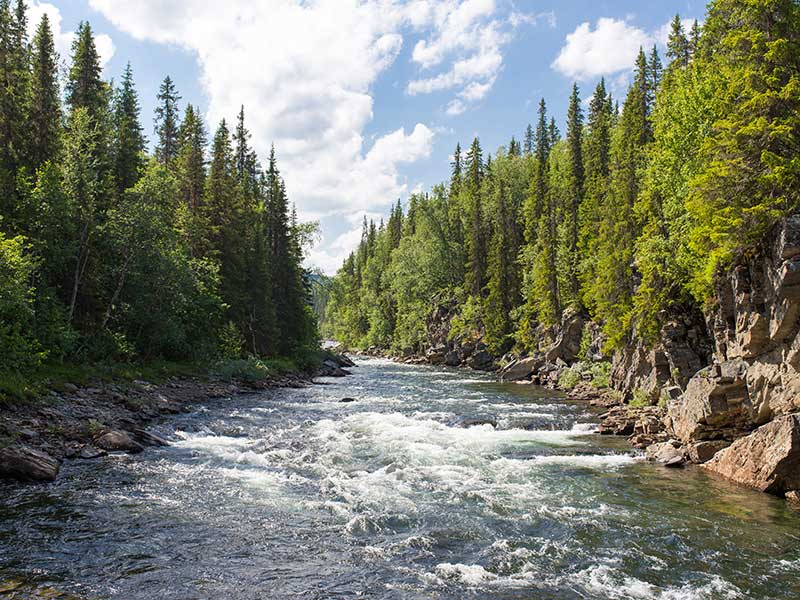How to cross a river safely

Many hiking enthusiasts like to try new routes and discover beautiful landscapes in their surroundings. Encountering beautiful streams may seem exciting at first glance, but you need to know how to cross them safely to avoid running any kind of risk.
For the more adventurous ones, we have prepared this article where we will talk about how to cross rivers or streams safely. You will be able to apply these tips in your day by day as a hikerwhich will greatly facilitate your physical activity in the mountains, where intelligence plays a key factor for your security.
Tips for crossing a river or stream easily and safely
Crossing rivers or streams requires special skills for both professional hikers and novices who have never been in such a situation. Whichever group you belong to, continue reading this article where you can learn a number of tips and tricks. tactics to cross rivers or streams easily and safely.
It is important for all hikers to know their own limits and at the same time it is essential to know the environment they are crossing. In the area of rivers or streams there is an extra factor that is the force with which it flowsThe higher it flows, the more dangerous it is.
Often there are a number of rocks and logs that act as a natural bridge to cross the river. However, especially in humid climates, heavy rainfall can cover these natural elements with other elements such as moss, leaves or algae. The result is either the loss of these natural elements or that they become slippery.
It is clear that nobody wants to end up on the river bank with a twisted ankle, soaking wet or even worse, being swept away by the current. be aware of the danger The first piece of practical advice we can give you is to cross a river or stream.
You should also bear in mind that river velocity and flow differ from one season to another. During summer days, streams run at a low to medium level, while during winters or early spring, rivers flow at a high level. Before starting with the practical tips, it is necessary to keep in mind that it is always advisable to check the local recommendations as some areas are different from others.
Tips for before leaving home
Any physical activity requires good preparation and equipment. Safety starts in our homes with preparation, the physical activity we are going to do is almost as important as doing it.
- Take a look at the environmental conditions where you will be walking and check if there are any online resources for contacting local guides, tourism technicians or experienced mountaineers in the area.
- Have trekking poles will help you check the height of the water while providing support and stability along the way.
- Use shorts is a good way to prevent the force of the water from washing you away. Wet long trousers are also more uncomfortable, so keep that in mind. And in winter they won't be an option.
- The footwear plays an important role when crossing rivers or streams. You can swap your boots for hiking sandals when crossing the water, they will help you walk through the water and jump from rock to rock.
Advice on reaching the river or stream
Once you get to the river or stream stop to think about how, when and where you are going to cross the river. Don't be in a hurry and take your time to do so, safety is the most important thing.
- It starts with evaluate the place and analyse which is the best way to cross.
- Wait for the right moment to do it, if you find branches or debris floating in the water it is not the right moment to do it, wait until the water calms down.
- It is important to analyse the breaks in the river, the ramifications will make some areas wider than others.
- Check the current, water direction and speed. If the current is fast, the risk will be greater.
- Avoid deep water crossings.
- When you are ready to cross the river make sure that all the items you are carrying are secure and securely attached to you. If the current is very fast, it may be safer to throw your rucksack with everything in it to the other side and cross with nothing to prevent anything from destabilising you.
- Last but not least, look for the best way out at the other end of the river. A low exit point will be much more stable and safer than a steep exit.
Once you're across the river...
Once you cross the river, slide your feet forward slowly. You should walk diagonally towards the flow as you move towards the opposite bank. Remember that there is no hurry and that it is often wiser to waste time on a particular stretch than to try to move quickly.
Use the trekking poles to keep you steady in the water as you move forward and move your feet. Crossing the river or stream will be safer and more stable the more contact you have with the ground.
Don't miss any adventure in the Pyrenees!
